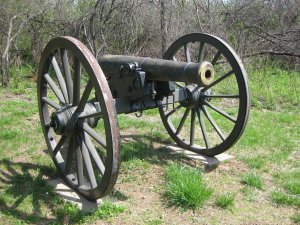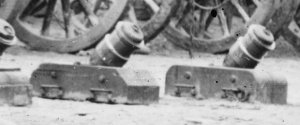Weapons
The most common small arms weapon carried by the Federals were rifle-muskets that used 0.69-caliber ball ammunition and a version of the newly adopted Springfield rifle-musket, Model 1855 or possibly 1861 that fired the 0.58-caliber Minie ball. The 1st Illinois Cavalry were armed only with sabers and single shot pistols.
 |
 |
For artillery, the Federal defenders had nine artillery pieces. Seven of these were the same smooth bore, Model 1841 6-pounder Guns used by the Missouri State Guard. There were two gun batteries, one in the Lafayette County Home Guard and one manned by U.S. Reserve Corps Infantry Battalion. Two mortars were also in use, manned by the Lafayette County Home Guard, most likely Model 24-pounder Coehorn Mortars.
The Missouri State Guard used a wide variety of small arms, including conversion muskets, hunting rifles, carbines, and shotguns, that greatly complicated the logistics of keeping the troops supplied with ammunition. They were using a significant number of the 0.58-caliber Springfield rifle-musket, Model 1855 or possibly 1861, that had been captured from the Federals during the Battle of Wilson's Creek.
For artillery, the Missouri State Guard had five batteries, totaling 16 artillery guns. They used the smooth bore, Model 1841 6-pounder Guns. Bledsoe's Battery also deployed "Old Sacramento," a gun captured during the Mexican War that had been adapted to fire a 12-pound projectile.

Guns were designed to fire solid shot projectiles at high velocity, over low trajectories at targets in the open, although shot and canister were acceptable for use. The barrels of the guns were longer than corresponding howitzers, and called for higher powder charges to achieve the desired performance.
Here's a link to a video that demonstates artillery fire by a gun crew.

While guns were intended to batter down the walls of a fortification, mortars were designed to fire explosive shells in a high arc over the walls of fortifications. The barrels of the mortars were short and they only required a small powder charge. Coehorn mortars were lighter mortars, designed to be carried about by four men. Coehorn mortars were classified as a siege and garrison weapon. It took five men to operate a mortar.
|
Model 1841 6-pounder Gun |
Model 1841 Coehorn Mortar |
|
|
Bore Diameter |
3.67 inches |
5.82 inches |
|
Tube Weight |
884 pounds |
164 pounds |
|
Tube Length |
60 inches |
16.3 inches |
|
Carriage Weight |
900 pounds |
132 pounds |
|
Range |
1,523 yards (at 5 degrees) |
1200 yards (at 45 degrees) |
|
Projectile Weight |
Shot = 6.15 pounds |
Shell = 17 pounds |
|
Powder Charge |
1 - 2 pounds |
0.5 pounds |
